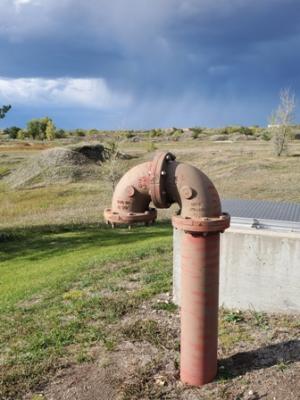NRCS to Fund More Conservation Practices to Protect Drinking Water
The USDA Natural Resources Conservation Service of North Dakota has laid the foundation to beef up protection of Grafton’s and Park River’s drinking water.
Grafton (pop. 4,000) gets its drinking water mainly from the Red River. It also draws water from the Park River when its Red River inlet pumps are down for maintenance.
The city of Park River (pop. 1,300) gets its drinking water from an underground aquifer. The Homme Dam reservoir – a low quality source frequently impaired by blue green algae blooms – is its alternate source.
NRCS recently completed an assessment of the two communities’ drinking water and received funding through a National Water Quality Initiative (NWQI) for conservation measures that will help protect the water. It’s the first such use of NWQI funds to specifically target drinking water sources in the state. The funding is administered through the Environmental Quality Incentive Program (EQIP).
“Many people in Grafton and Park River may not understand that their drinking water doesn’t come from deep underground aquifers that are filtered by hundreds of feet of soil or bedrock” says Rita Sveen, NRCS watershed conservationist, Park River. “They are getting their water from surface water that runs off into the Red and Forest rivers and from ground water in a shallow aquifer that is only about 30 feet below the soil surface.”
Both cities treat their water and neither city’s treated drinking water is currently impaired. The treated water does not contain high levels of contaminants, such as farm or industrial chemicals, or high levels of phosphorus or nitrates.
However, in the past, trace amounts of some herbicides, insecticides and fungicides have been detected in the water before it was treated. Some of the pesticides commonly used today are not being tested for regularly or at all due to testing or technology limitations.
Without additional protection, “there is a significant risk of potential contamination in the future,” Sveen says.
Grafton’s solutions
In meetings conducted by NRCS, Grafton community leaders and other stakeholders agreed that they are most concerned about agricultural run-off into the Red and Forest rivers and the possible effect of increased tile drainage on the rivers.
The overall quality of Red River water is a concern, too. The level of phosphorus and nitrogen in the river has been increasing since 1994. But the Red River Basin Commission, the International Red River Board and federal and state agencies have developed strategies to reduce these nutrient loads.
In the 6,500-acre watershed closest to Grafton’s pumps in the Red River, conservation practices that keep soil and water on the land and prevent runoff of sediment and chemicals could help protect the water quality. Those conservation practices include no-till, cover crops, windbreaks and conversion of cropland to grazing land or wildlife habitat. Careful integrated nutrient and pest management would reduce the amount of crop inputs being applied to the land.
Park River’s proposals
Park River leaders and stakeholders are worried about contaminants leaching into the aquifer that they draw their drinking water from. The watershed covers about 4,700 acres and is intensively cropped, with few conservation practices being used on the land. In recent years, much of the land that had been put into the Conservation Reserve Program has been converted back to cropland.
There also are four active gravel pits and one abandoned gravel pit near the 10 wells the city uses to pump water from the aquifer. The wells were drilled in 1968 by the U.S. government to supply water to what is now the Cavalier Air Station in Pembina County. Oil and gasoline spills and leaks from large machinery used in the gravel pits, and the dumping of chemicals in the pits’ open water are significant risks. Both have occurred in the past.
Should the wells become contaminated, drilling new ones would be a significant financial challenge for Park River.
On the farmland, conservation practices such as no-till, cover crops, shelterbelts, integrated nutrient and pest management and conversion of cropland to grasslands or wildlife habitat would help protect the water from contamination.
To protect the aquifer from contamination originating at the gravel pits, an educational campaign is needed. Sveen believes gravel operators and the public would take more care with equipment fluids, excess fertilizers and pesticides, if they were more aware of the shallow depths to drinking water resources. NRCS is also considering reinstating conservation payments for Gravel Mine Reclamation practices. Proper mine reclamation helps ensure mines are capped with sufficient soil and vegetation which helps prevent the leaching of contaminants.
Sign up underway
The National Water Quality Initiative is giving conservation in the targeted watersheds a boost.
“We were interested in trying some of the practices anyway,” said one farmer who signed up in 2021 to try no-till and cover crops but did not want to be identified. “This program has gotten us off the fence. We’re concerned about drinking water quality, too. These practices look like a win-win.”
For more information about protecting water quality, see your local NRCS office.

Media contact:
Lon Tonneson
for the Natural Resources Conservation Service - North Dakota
lon.tonneson@gmail.com
701-361-1105

